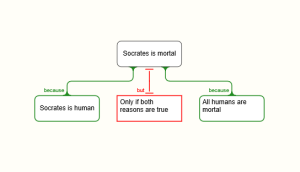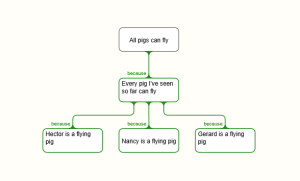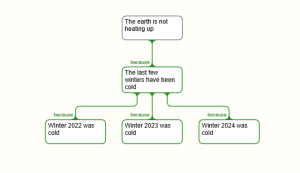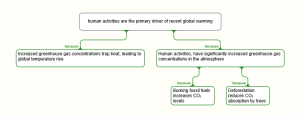1 Arguments and inference
Introduction
Philosophers rely heavily on arguments to justify claims. This has motivated reflections on what arguments and argumentation even are for millennia. Moreover, argumentative practices are ever-present in scientific inquiry, legal procedures, education, and political institutions. The study of argumentation is an interdisciplinary field of inquiry, involving not only philosophers but also language theorists, legal scholars, cognitive scientists, computer scientists, and political scientists, among many others.
Validity and soundness
Validity refers to the structure of an argument. An argument is valid if its conclusion logically follows from its premises. Even if the premises are false, an argument can still be valid as long as the reasoning is correct. For example:

- Premise 1: All pigs can fly.
- Premise 2: Gerard is a pig.
- Conclusion: So, Gerard can fly.
This is a valid argument because the conclusion follows the premises, even though premise 1 is obviously false.
Soundness goes one step further. An argument is sound if it is valid and if all its premises are true. For an argument to be sound, it must have both correct reasoning (validity) and factual premises. Take the following example:

- Premise 1: All humans are mortal.
- Premise 2: Socrates is a human.
- Conclusion: So, Socrates is mortal.
This is a sound argument because it is valid, and both premises are true. As can be seen, sound arguments are always valid, but valid arguments are not always sound because the form of the argument may be correct, even if it does not have true premises. All good arguments have a basic pattern of connecting premises to reach a conclusion. In the following paragraph I will explain two more prevalent forms of arguments.
Deduction and induction
As we have seen, an argument is made by constructing premises in such a way that they support some kind of conclusion. In general, when an argument is valid and sound, a conclusion simply follows from the premises. That is to say, if one believes that the premises are true and the inference is valid, then one is automatically committed to the truth of the conclusion. Such arguments are deductive in nature, and the wonderful thing about them is that they guarantee certainty. That is to say, if the argument follows the form of syllogism as stated above and uses true premises, then the conclusion is necessarily true. This formal structure ensures the validity of the reasoning. Deduction is essential for preserving truth in reasoning. This makes deductive reasoning a powerful tool in disciplines like mathematics and logic, where certainty is crucial.
While deduction offers certainty, it does not generate new knowledge beyond what is already contained in the premises. It works by unpacking the logical implications of what is already known, rather than discovering new information like induction does. Induction, consequently, does not provide absolute certainty—its conclusions are possible but not necessary. Induction is more commonly used in everyday reasoning. We make predictions based on past experiences, like assuming that traffic will be heavy during rush hour because it usually is, even though there is no certainty.
Take an example about flying pigs. If we want to use induction to argue that pigs can fly, the premises and conclusion will have the basic argumentative structure that works as follows:

- Premise 1: Every pig I’ve seen so far can fly.
- Premise 2: Gerard is a pig.
- Conclusion: Gerard can fly.
Induction works by drawing general conclusions based on specific observations or examples. In other words, you infer a general rule or pattern from particular instances. For example, if you observe that the sun has risen every morning for your entire life, you might conclude that the sun will rise again tomorrow. In our case of the flying pigs, the more pigs we observe that can fly, the more likely it becomes that all pigs can fly. The strength of an inductive argument depends on how well the premises support the conclusion. The more observations or data points supporting the conclusion, the stronger the argument.
A good induction relies on a large and representative sample of evidence, which reduces the chances of error or bias. If more observations are made or more evidence is found, then this provides more support for the conclusion, making it more probable, even though it is still not guaranteed to be true. Inductive reasoning is also strengthened when it draws from a wide range of examples across different conditions. If the examples are too narrow or similar, the conclusion may be less reliable. Furthermore, inductive arguments should remain open to revision if new evidence arises. After all, a good induction does not claim absolute certainty but presents conclusions that are likely, based on current information.
A favorable analogy that has always helped me understand the ends of induction and deduction is the thought that deduction deals with absolute truths while induction deals with ‘gradual’ truths. Think about a statement having a value of either a 1 if it is true, a 0 if it is false and a value in between 1 and 0 based on how likely it is. So, I might believe that the statement ‘a rose is a rose’ is necessarily true, warranting me to assign a 1 to it. And since I have seen the sun rise every morning for 26 years now, I might assign a 0.99 to the statement ‘the sun will rise tomorrow’ because I am convinced that it is very likely that such an event occurs. But, when saying ‘on June 2nd, 2045, I will eat mashed potatoes for dinner’ I might assign a 0.01 to it, since, while I do like mashed potatoes, I have no evidence whatsoever that such an event will occur.
Arguments about climate change: The weather
We can construct an incredible number of relevant arguments within the discussion regarding climate change. It would do us no good to go over every single argument mentioned in this discussion. Some arguments aim to support or undermine the phenomenon of global warming. I will focus on these arguments. I do not think it is possible for this analysis to be exhaustive. For our current purposes, showing the conditions under which these conclusions hold should be sufficient.
Let us take a look at some arguments surrounding the discussion of global warming. Take the following sentence:
‘The last few winters have been so incredibly cold; I don’t see the Earth heating up any time soon.’
What if we try to make the expression of the argument more concrete by putting it in such a way that the inference becomes clear? I think the expression can be translated as follows:

- Premise 1: The last few winters have been cold.
- Premise 2: If the last few winters have been cold, then the Earth is not heating up.
- Conclusion: The Earth is not heating up.
Note that I have added a second premise in order for the argument to have some inferential structure. This inferential step is already implicit in the argument. Now, it seems like a deductively valid argument because if 1 and 2 are true, then the conclusion is logically implied. But are 1 and 2 true? Premise 1 can be true but is probably subjective to what we take the term ‘cold’ to mean. Cold to one person might be -20°C while another will be shivering as soon as the temperature drops below 20°C.
Regarding premise 2, weather seems to have been confused with climate. Weather changes day to day, while climate refers to long-term patterns—and the long-term trend is definitely warming. While global warming is just starting to affect northern countries, tropical regions have been dealing with it for years.
The argument could also function as an example of inductive reasoning because it uses specific examples and observations to support a broader conclusion. Inductive arguments start with particular instances and move toward a generalization, which is happening here in a few ways.
The specific observation is that there is a cold winter. This is just one isolated weather event. The generalized conclusion is that global warming is not real. But, using long-term climate data it is evident that while weather fluctuates, the general climate trend is one of warming, which is supported by evidence from farmers in the tropics experiencing droughts, floods, and pests. The following video is a simple explanation of the difference between a trend and the variation:
Arguments about climate change : Hurting the economy
A less anecdotal argument comes from a paper from the Manhattan Institute. It argues that actions to reduce greenhouse gas emissions, particularly through international agreements like the Kyoto Protocol, could harm the economy. It critiques such policies for disproportionately burdening developed nations like the United States while exempting major emitters such as China and India. This imbalance is argued to create a competitive disadvantage and to impose significant costs on industries and consumers. The paper also questions the efficacy of emissions reductions, given uncertainties in climate science regarding the extent to which human activities drive global warming. The idea is that the economic sacrifices required for these policies may not lead to commensurate environmental benefits. Take a look at the following argument:
- Premise 1: Policies requiring significant economic sacrifices are unjustifiable if their benefits are uncertain.
- Premise 2: Policies to reduce greenhouse gas emissions require significant economic sacrifices, and their benefits are uncertain.
- Conclusion: Therefore, policies to reduce greenhouse gas emissions are unjustifiable.

This argument is valid in its current form but premise 2 is a bit shaky. It assumes the benefits of emissions reductions are uncertain without fully addressing scientific consensus on climate change or potential long-term global impacts. It also overlooks the economic benefits of mitigation, such as job creation in renewable energy and reduced costs of climate-related disasters. The premises of this argument require deeper evaluation of both the costs and the benefits of environmental action to strengthen its persuasiveness.
Arguments about climate change: Scientific consensus
The overwhelming consensus among scientists is that human activities, particularly the burning of fossil fuels and deforestation, are the primary drivers of the recent spike in global temperatures. The evidence is compelling: greenhouse gas emissions from industrial activities trap heat in the Earth’s atmosphere, leading to rising temperatures, melting ice caps, and more frequent extreme weather events. These changes are already affecting ecosystems and human populations, particularly in vulnerable regions. The ethical argument is clear: if human actions are causing this harm, then we have a moral responsibility to take immediate and effective steps to mitigate these effects.
The scientific consensus argument, widely cited in reports from the Intergovernmental Panel on Climate Change (IPCC), can be formalized as follows:
- Premise 1: Human activities, especially the burning of fossil fuels, have significantly increased greenhouse gas concentrations in the atmosphere (empirical data from industrial emissions).
- Premise 2: Increased greenhouse gas concentrations trap heat, leading to global temperature rise (well-established physical principle).
- Conclusion: Human activities are the primary driver of recent global warming.

This argument is both valid and inductively strong. It is supported by extensive empirical evidence, including temperature records, atmospheric gas measurements, and climate models. The IPCC’s Synthesis Report (2023) states with high confidence that human influence is the dominant cause of observed warming since the mid-20th century.
The consensus among scientists is based on thorough scientific research, i.e. inductive reasoning. Even though inductive proof does not give 100% certainty, there is a myriad of reasons to support the claim that global warming is real. The most prominent research group is the IPCC. Even they do not pretend to be absolutely certain about their results, stating that human influence is ‘very likely’ (90%) the main driver of the global retreat of glaciers since the 1990s and the decrease in Arctic sea ice. So, what makes them so certain in their claims regarding global warming? Their research is considered very strong because it relies on a large and representative sample of evidence. It draws from a wide range of examples across different conditions, since their research is conducted globally. In order to reducing bias, they draw their conclusions from different working groups that work independently. Combining their data, all signs point towards the reality of global warming. In their Synthesis Report, the IPCC summarizes the state of knowledge of climate change, its widespread impacts and risks, and climate change mitigation and adaptation.
Philosophical exercises
1. In life we are often confronted with arguments. But rarely do people ever present their arguments in a formal scheme. In fact, I think it would take all the fun out of conversation. Think of some arguments you have heard, simple or difficult, and try to put them into a schematic form. Are the premises true? How is the conclusion implied by the premises? Is it a deductive or an inductive argument?
2. Practice identifying hidden assumptions within arguments and consider the broader implications of accepting the argument as true. Maybe choose a common belief or argument that is often taken for granted. It could be about morality, social norms, or practical advice. This belief might seem straightforward but contains underlying assumptions that are not immediately obvious. Put the argument into a formal structure by identifying the premises and the conclusion as you did for the first exercise, but this time think about any assumptions the argument makes that are not directly stated. If this argument was considered absolutely true, what would be the consequences? Based on your analysis, try to refine the argument or make it more specific. You could qualify the conclusion or adjust the premises.
Non-philosophical skill:
Development of visual representations of arguments with software for graphic design.
Argument mapping.
References
Intergovernmental Panel on Climate Change. (2023). Climate change 2023 synthesis report: Summary for policymakers. IPCC. https://www.ipcc.ch/report/ar6/syr/
Schulz, M. (2007). Energy and the Environment: Myths and Facts. Manhattan Institute for Policy Research. https://media4.manhattan-institute.org/sites/default/files/Energy_and_Environment_Myths_Facts.pdf
